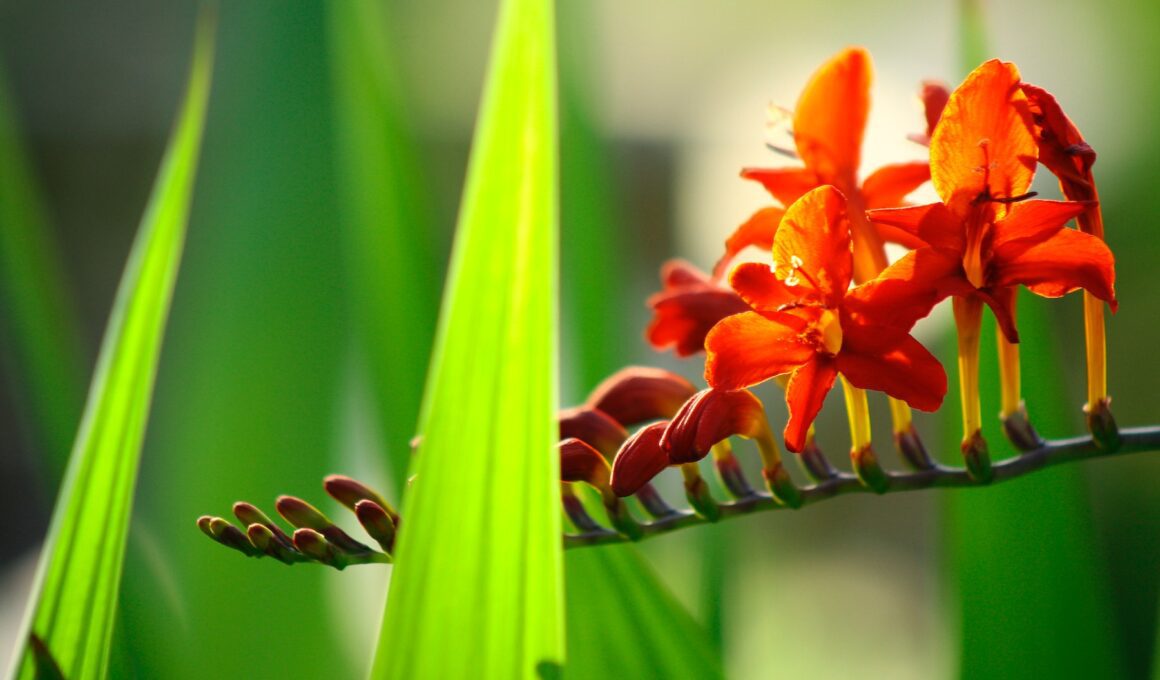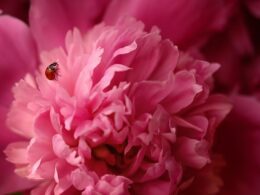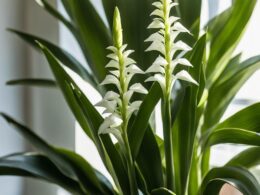Are you a fan of crocosmia, but unsure of how to care for the plants during the winter months? Don’t worry, we’ve got you covered.
Crocosmia plants, also known as montbretia, are native to South Africa and are often grown for their beautiful, colorful flowers that bloom in late summer. However, as the weather turns colder, it’s important to take the necessary steps to ensure your crocosmia plants survive the winter and come back stronger in the spring.
In this article, we’ll provide you with simple and easy-to-follow tips for preparing your crocosmia plants for winter, storing your corms in a cool, dry place, checking on your corms throughout the winter, and replanting your corms in the spring. We’ll also cover how to maintain your crocosmia plants throughout the growing season, so you can enjoy their vibrant colors year after year.
So, sit back, relax, and let’s dive into the world of crocosmia care.
Prepare Your Crocosmia Plants for Winter
Get your crocosmia plants ready for the colder months by taking these necessary steps. Caring for crocosmia in winter involves mulching and protection from frost.
Start by pruning back the foliage to about 6 inches from the ground. This will help your plants conserve energy during the winter months.
Next, cover the soil around the base of the plant with a 3-inch layer of mulch. This will help insulate the soil and protect the plant’s roots from extreme temperatures.
As for protecting your crocosmia from frost, cover the plant with a frost blanket or burlap if frost is expected. This will help keep the plant warm and protect it from damage.
If you live in an area with very cold winters, you may want to consider digging up your crocosmia corms and storing them indoors for the winter. Winter storage alternatives for crocosmia corms include storing them in a cool, dry place or replanting them in pots and keeping them indoors.
Storing your crocosmia corms indoors has its pros and cons. On one hand, it can protect your plants from harsh winter conditions and ensure they are ready to plant in the spring. On the other hand, it can be time-consuming and requires careful handling of the corms. Ultimately, the decision to store your crocosmia corms indoors or leave them in the ground during the winter months will depend on your climate and personal preferences.
Store Your Corms in a Cool, Dry Place
When storing your crocosmia corms for the winter, make sure to remove any excess soil. Separate the corms and label them to keep track of which ones are which. This will ensure that your crocosmia plants have a better chance of thriving when you plant them again in the spring.
Store your corms in a cool, dry place. This is essential to prevent them from rotting or getting damaged during the winter months.
Also, make sure to check your corms periodically throughout the winter to ensure they are still in good condition. If you notice any soft or moldy corms, remove them immediately to prevent the spread of disease.
In summary, by taking the necessary steps to properly store your crocosmia corms, you can ensure that they will be healthy and ready to plant again in the spring.
Remove Any Excess Soil
Before storing your crocosmia bulbs for the season, make sure to shake off any excess soil to prevent mold growth and ensure the bulbs stay dry. The excess soil can trap moisture, which can cause the bulbs to rot over time.
To remove the soil, gently tap the bulbs against a hard surface, like a table or the edge of a pot. You can also use a soft-bristled brush to gently sweep away any remaining soil.
Once you’ve removed the excess soil, it’s important to store the bulbs in a cool, dry place to prevent them from drying out or becoming damaged. Here are three tips to help you store your crocosmia bulbs properly:
-
Choose a storage container that allows for good air circulation, like a paper bag or a mesh bag. Avoid using plastic bags, which can trap moisture and promote mold growth.
-
Label your storage container with the name of the plant and the date you stored it. This will make it easier to keep track of your bulbs and ensure you plant them at the right time in the spring.
-
Store your bulbs in a dark, cool place, like a basement or a garage. Avoid storing them near heaters, windows, or other sources of heat or light, which can cause the bulbs to dry out or become damaged.
Separate the Corms
To properly prepare your crocosmia bulbs for storage, it’s essential to separate the corms carefully to avoid damaging them. Corms are the underground storage organs that enable the plant to survive the winter and grow again in the spring. Not only does separating the corms allow for easier storage, but it also provides an opportunity for propagating crocosmia.
When separating the corms, use a sharp knife or garden tool to gently cut them apart, making sure to leave some of the roots intact. As you separate them, inspect each corm for any signs of damage or disease, discarding any that appear unhealthy. Once separated, place the corms in a cool, dry, and well-ventilated area for a few days to allow them to dry out before storing them in a container with peat moss or vermiculite. Following these corm storage tips can help ensure the success of your crocosmia plants for years to come.
| Propagating Crocosmia | Corm Storage Tips |
|---|---|
| Wait until late summer or early fall to divide the corms. | Cut off any dead foliage before storing. |
| Use a sharp knife or garden tool to gently separate the corms. | Place corms in a container with peat moss or vermiculite. |
| Inspect each corm for signs of damage or disease. | Store container in a cool, dry, and well-ventilated area. |
Label Your Corms
Labeling your corms is a crucial step in ensuring successful storage and propagation of your crocosmia plants. When separating your corms, it’s easy to forget which variety is which. By labeling each corm with the name of the variety, you can keep track of which ones are which and avoid confusion come planting time.
A simple label with the name of the variety and the date it was separated will do. Storage tips are important to keep in mind when labeling your corms. Once you’ve labeled each one, store them in a cool, dry place until you’re ready to replant them.
Avoid storing them in a place that gets too cold or too hot, as extreme temperatures can damage the corms. Additionally, make sure they are stored in a place where they won’t be disturbed or knocked over.
Following these labeling instructions and storage tips will help ensure the success of your crocosmia plants in the coming season.
Should Crocosmia Herbs Be Cut Back For Winter?
Crocosmia herbs should be given the necessary attention when cutting back for winter. Trimming the foliage to ground level after the first frost helps protect the plants from harsh winter conditions and encourages regrowth in the following season. Cutting back herbs for winter ensures their longevity and healthier growth in the long term.
Check on Your Corms Throughout the Winter
Keep an eye on those corms all winter long to ensure a healthy and thriving crocosmia come springtime. Checking on your corms is crucial to avoid any issues that may arise during the winter months. Here are some tips to keep your crocosmia healthy during the winter:
- Check on your corms every two weeks to make sure they’re not getting too dry or too wet.
- Inspect the corms for any signs of rot or disease, such as mold or soft spots. Remove any affected corms immediately to prevent the spread of disease.
- If your crocosmia is in a container, move it to a sheltered area such as a garage or shed to protect it from harsh winter weather.
- Cover your crocosmia with a layer of mulch or straw to keep the soil moist and protect the corms from freezing temperatures.
- If you live in an area with severe winter weather, consider digging up your corms and storing them in a cool, dry place until spring.
By keeping a close eye on your crocosmia corms throughout the winter, you can ensure a healthy and thriving plant come springtime. Checking frequency is essential to catch any issues early on and prevent them from becoming more severe. Common issues include mold, soft spots, and disease, so make sure to inspect your corms regularly. Following these simple tips will help keep your crocosmia safe and protected through the winter months.
Replant Your Corms in the Spring
Once the winter season has passed, it’s imperative to replant your crocosmia corms in the spring to ensure a healthy and successful growing season. Spring planting should be done as soon as the soil is workable, usually around mid-March.
Before replanting, it’s important to check the corms for any signs of damage or disease. Remove any damaged or rotten parts before planting to prevent the spread of diseases.
Corm maintenance is essential for the longevity of your crocosmia plants. After replanting, make sure to water the corms regularly and keep the soil moist but not waterlogged. Fertilize with a balanced fertilizer during the growing season, and mulch to help retain moisture and suppress weed growth.
In the fall, stop watering the corms and allow the foliage to die back naturally. Once the foliage has withered, you can dig up the corms, separate any offsets, and store them in a cool, dry place until spring planting season.
By following these simple steps for spring planting and corm maintenance, you can ensure a successful growing season for your crocosmia plants. Proper care and attention will result in healthy plants with vibrant blooms that will bring joy and beauty to your garden for years to come.
So, get ready for spring planting and enjoy the rewards of a well-maintained crocosmia garden.
Should I Leave Crocosmia In The Ground Over Winter Like Hostas?
Yes, leaving hostas in winter is common practice, but the same doesn’t hold true for crocosmia. Unlike hostas, crocosmia bulbs should be lifted and stored in a cool, dry place over winter. This helps protect the bulbs from freezing temperatures and ensures they’ll return in full bloom the following year.
Maintain Your Crocosmia Plants Throughout the Growing Season
When maintaining your crocosmia plants throughout the growing season, there are three key points to keep in mind. First, fertilize your plants to ensure healthy growth and beautiful blooms.
Second, deadhead your plants regularly to encourage continued flowering and prevent the spread of disease.
Finally, divide your corms every few years to keep your plants healthy and prevent overcrowding.
By following these simple steps, you can enjoy a stunning display of crocosmia in your garden all season long.
Fertilize Your Plants
Give those plants a little boost with some fertilizer to help them thrive during the colder months. Crocosmia plants are hardy, but they still need some extra nutrients to help them survive the winter.
Here are some tips for fertilizing your plants:
- Use a slow-release fertilizer that will gradually release nutrients over time.
- Apply the fertilizer in the fall, before the first frost hits.
- Water your plants well after fertilizing to help the nutrients soak in.
By fertilizing your crocosmia plants, you’ll be setting them up for success during the winter months. They’ll be better equipped to withstand the cold temperatures and will come back even stronger in the spring. So take the time to give your plants the care they need and watch them thrive.
Deadhead Your Plants
To keep your crocosmia plants looking their best, it’s essential to deadhead them regularly during the growing season. Deadheading is the process of removing spent flowers from the plant, and it has several benefits. Firstly, it encourages the plant to produce more blooms, which means you’ll get more flowers throughout the season. Secondly, it helps to prevent the plant from self-seeding and spreading too quickly, which can be beneficial if you’re trying to control the growth of your crocosmia.
The best time to deadhead your crocosmia plants is when the blooms start to fade and wither. You can do this by cutting the stem just above the first set of leaves or buds. If you leave the stem too long, it will start to brown and look unsightly. By deadheading regularly, you’ll not only keep your plants looking their best, but you’ll also encourage them to produce more flowers, which is always a welcome sight in the garden.
| Column 1 | Column 2 | Column 3 |
|---|---|---|
| Benefit 1 | Encourages more blooms | Get more flowers throughout the season |
| Benefit 2 | Prevents self-seeding | Helps control plant growth |
| Best Time | When blooms start to fade and wither | Cut stem just above first set of leaves/buds |
In conclusion, deadheading your crocosmia plants is an essential part of their care routine. It not only keeps them looking their best, but it also encourages them to produce more flowers and helps control their growth. Remember to deadhead when the blooms start to fade and wither, and cut the stem just above the first set of leaves or buds to promote healthy growth. By following these simple steps, you’ll be able to enjoy a beautiful display of crocosmia flowers throughout the growing season.
Divide Your Corms
If you want your crocosmia plants to thrive and multiply, it’s time to learn how to divide their corms. Propagation methods are essential to keep your crocosmia plants healthy, and dividing their corms is the best way to achieve this.
You can do this in the fall or early spring, just before the growing season begins. To divide the corms, you need to dig up the plant and remove the soil around its roots. Next, gently separate the corms, ensuring that each piece has at least one healthy shoot and root system.
Once you have separated the corms, replant them in well-draining soil, ensuring that they have enough space to grow. It’s also important to note that corm storage techniques can vary depending on the variety of crocosmia you have, so make sure to research the specific storage needs of your plant.
By dividing your crocosmia corms and practicing proper storage techniques, you can ensure a healthy and flourishing plant for years to come.
Frequently Asked Questions
Can crocosmia survive in extremely cold temperatures?
Protecting crocosmia during winter requires some preparation. This plant isn’t able to survive extremely cold temperatures on its own.
To ensure its survival, you’ll need to provide some winter care for crocosmia. This includes mulching the soil around the roots to keep them insulated from the cold, covering the plant with a thick layer of straw or leaves, and keeping the soil moist but not saturated.
By taking these steps, you can protect your crocosmia and ensure that it’ll thrive come spring. Remember, a little bit of extra care now can go a long way in ensuring the health and safety of your plants.
Is it necessary to dig up crocosmia corms every winter?
To ensure the survival of your crocosmia during the winter months, proper winter storage is essential. One common method is to dig up the corms and store them in a cool, dry location. Before storing, remove any dead foliage and allow the corms to dry completely. Then, place them in a container with peat moss, sawdust, or vermiculite.
Check them periodically throughout the winter to make sure they remain dry and firm. With these simple steps, you can ensure the survival of your crocosmia and enjoy their beautiful blooms year after year.
How often should I check on my stored crocosmia corms during the winter?
Storing Crocosmia Corms: Best Practices, Overwintering Tips, and Troubleshooting Common Crocosmia Corm Storage Issues are important topics to consider if you want to ensure the survival of your crocosmia plants during the winter months.
To start, make sure to store your corms in a cool, dry place with good ventilation.
Check on them regularly to make sure they remain dry and firm. If you notice any signs of rot or mold, remove the affected corms immediately to prevent further spread.
It’s also important to label your stored corms to avoid confusion when planting them in the spring.
With these simple tips, you can safely store your crocosmia corms and enjoy beautiful blooms year after year.
Can I replant crocosmia corms in the fall instead of waiting until spring?
If you’re thinking about replanting your crocosmia corms in the fall, it’s important to understand how to care for them during the winter months.
To ensure that your plants remain healthy and strong, you should keep them in a cool, dry location that is protected from the elements. This will help prevent the corms from rotting or becoming damaged due to freezing temperatures.
When replanting in the fall, it’s also important to make sure that the soil is well-drained and that you are planting the corms at the proper depth.
By following these simple steps, you can enjoy beautiful crocosmia blooms throughout the growing season.
How much water and fertilizer should I give my crocosmia plants during the growing season?
To keep your crocosmia plants healthy and thriving during the growing season, you’ll need to pay attention to their watering frequency and fertilizer application.
Watering should be done regularly, but not too much at once as this can cause root rot. A good rule of thumb is to water deeply once a week, and more often during periods of hot or dry weather.
When it comes to fertilizer, it’s best to apply a balanced, all-purpose fertilizer every 4-6 weeks during the growing season. This will provide your plants with the nutrients they need to produce healthy foliage and blooms. Just be sure not to over-fertilize, as this can lead to excessive growth and weakened plants.
By following these simple guidelines, you can help ensure that your crocosmia plants thrive throughout the growing season.
Conclusion
So, you wanna know what to do with your crocosmia plants in the winter? Well, the first step is to prepare them for the cold months ahead. Cut back the foliage and remove any dead or damaged parts of the plant. This will help prevent disease and pests from taking hold.
Next, it’s time to store your corms in a cool, dry place. You can use a paper bag or a plastic container with some ventilation holes. Check on your corms throughout the winter to make sure they’re not rotting or drying out.
In the spring, replant your corms and maintain your crocosmia plants throughout the growing season. With a little bit of care, your crocosmia plants will reward you with beautiful blooms year after year.









